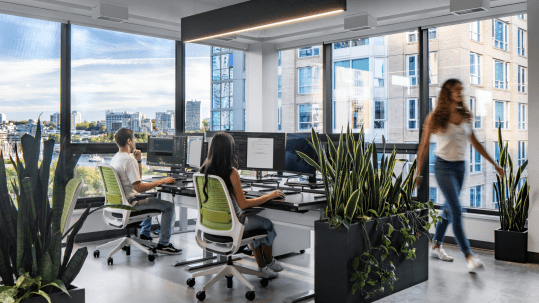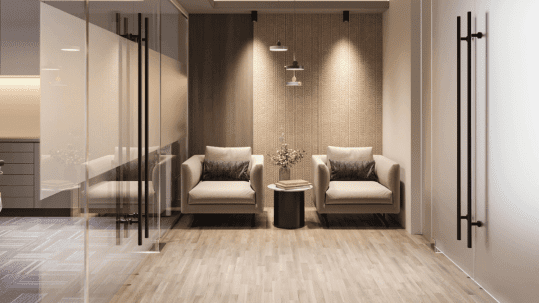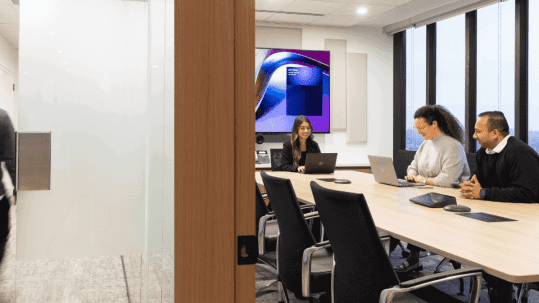Have you ever gone for a walk around the office to analyze if it has met your expectations? When you think about your company, your brand, does your office design represent your company culture? If you are a modern company with high-tech aspirations, do you have a modern office that showcases those traits? If the answer is yes, good for you! The majority of organizations, though, will find that their brand lacks representation in their office design.
The office environment plays a big role in conveying a company culture. Employees need to buy into the brand the same way customers do. Employees, though, need to buy in with the basis of the office design, where they work every day. Customers get more exposure to commercials, marketing campaigns. Employees spend time in conference rooms, offices, open areas within the office. Your brand should have as much representation in the office as it does on a commercial for customers.
Enter a Discovery Phase to Act on a New Office Design
You need to take action when it comes to a new office design that represents your brand and your company culture but remember, it is not always a matter of changing things up. You may need to go through a discovery session with a design & space planning firm to understand the needs of your company, where things may lack from a design space, and how you can improve. A powerful tool as part of this is the Aura Office Periodic Table of Office Design. Looking at each of its categories can help you better align your brand with your office design.
Style – Think about the style of your office and what lifestyle your brand represents. Do you have a brand that aims for a more retro vision, or is the gears more in the modern space? Do you cater to the millennial or urban crowd more than the traditional? Figure out what style works best.
Atmosphere – When you think about your brand, what is the atmosphere that comes to mind? Is it a bold brand, playful, vibrant? Figuring out the proper adjective can help with the design of an office to nail the feel. If you have a brand that is social, for example, you want an office design that has employees working in a very collaborative, open space.
Environment – What is the environment you expect from your office design? Is your brand one that will cater to the professional or the creative individual? Is it a cozy brand or a sophisticated brand? Think through the environment you seek with the office and how it meshes with your brand’s message.
Areas – What areas need to be a part of the office design? If you are going for a social atmosphere, areas that immediately come to mind include lunchrooms, lounge areas, and more. If it is more of a professional environment, having a reception and conference area will likely be a key need.
Features – What features would you expect in an office design? Again, for the social or unique settings, you want something like a rock climbing wall or pool table to get people in a creative mindset? If it is a sophisticated style your brand screams, going with glass walls or an exposed ceiling may be the way to go.
Texture – It may seem trivial to think about texture, but it says a lot about your office. It is as basics as whether or not you have shiny leather chairs or informal chairs at each cubicle or work station. The minor texture change can say a lot about the branding of a company.
Lighting – Lighting can make or break an office design. Does your brand aim more for the bright lights? Would lamps mesh better with the style, atmosphere, and environment you aim to achieve?
Furniture – Furniture is another key area that is very dependent on style, atmosphere, and environment. The furniture needs to meet the needs of employees, think ergonomics. You also have to have the furniture mesh with your brand as well.
It is the office design process of Aura that allows for the connection of a company’s brand, and the way the office looks. The design is not how it looks in the end, it is how it feels, how it works day to day, and how it meets the needs of employees, as well as clients and customers. By talking through the design using the periodic table, you will discover what will engage employees. Involve everyone at all levels, to give an opinion before you put any design thoughts into action.
Identify Your Company Culture
Do you know what culture of a company you want to set? Are you the type of company that is going to push the envelope, have a culture where engagement is important and employee retention high? You need to figure out the identity you seek. Branding your office around that identity and driving forward company culture is pivotal as part of the designing process.
The awareness of your company culture and how it links to your office design goes beyond employee perception. You likely will have customers and clients making their way into your office from time to time. When they enter the space, they want to experience your brand, your company culture from top to bottom. If you have a disconnect between the office design and the culture you push, there is a major problem there. Customers or clients may end up turning away from your product or service due to the impression the office space left on them. Do not let this happen to you!






